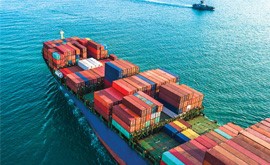The hard deadline for the 01 January 2020 switch to maximum 0.5% low-sulphur fuel for shipping has come into effect, although some shipowners and operators within the Red Sea reported that they still do not have access to or supplies of very low sulphur fuel oil (VLSFO) to comply with the rule, which does not have exemptions.
The International Maritime Organization and its member states have been discussing the sulphur cap regulation for a few years in order to support the transition. There is a goal of reducing greenhouse gas emissions by at least 50 percent, by 2050, which will involve a search for alternative fuels to get a really low carbon rating.
Elsewhere in the world there are reported instances of idle containerships waiting for compliant fuel. Several cases of laden ships at anchor, apparently waiting for LSFO [low-sulphur fuel oil] bunkers, have been recorded. One carrier severely affected is Singapore-based Pacific International Lines (PIL), which apparently has had at least six vessels anchored off of its home port since late last month, awaiting bunker supplies, They are all panamax ships deployed on Asia-West Africa trade lanes.
As the main bunkering hub in Asia, Singapore has seen high demand for VLSFO push the price for the compliant fuel to over $700 per ton, from around $550 at the beginning of December. Intra-Asia carriers will be hit particularly hard by this massive hike, given that HFO (heavy fuel oil) industry bunkers were available at below $300 per ton.
The situation is a little different in Europe. Several of the larger vessels bunkering at Rotterdam have exhaust gas cleaning scrubbers installed and are therefore able to continue to bunker with HFO, only taking on limited LSFO for ports where the use of scrubbers is banned. Even so, several container lines are looking to hike their low-sulphur surcharges for spot and short-term contract business.
CMA CGM announced last week it was increasing its LSS20 (low-sulphur surcharge) on 01 February. The carrier, which operates a number of scrubber-fitted vessels and is currently taking delivery of LNG-powered ULCVs, said it had reset its LSS20 at $275 per ton, following the $200 per ton value set on 1 December.
To calculate the amount to be paid by shippers, the surcharge is multiplied by a trade coefficient representing the fuel consumption per container.
As licensed Customs Brokers and International Freight Forwarders based in Brisbane, Colless Young offers you professional advice on all international trade and shipping activities, both import and export. We handle cargo through all Australian ports and airports.

